True/False
Indicate whether the
statement is true or false.
|
|
|
1.
|
The reason your head feels like it jerks backward when pulling away from a stop
sign is best explained by Newton's First Law.
|
|
|
2.
|
If two forces that are identical in strength but exactly opposite in direction
act on the same object, that object must necessarily be motionless.
|
|
|
3.
|
A child sits on a toboggan and slides down a hill with a particular
acceleration. If another child joins the first one on the toboggan, they will slide down the hill
with the same acceleration.
|
|
|
4.
|
If the vector sum of all forces acting on an object is precisely zero, the
object could still be moving.
|
|
|
5.
|
When drawing a proper free-body diagram, all forces, including the net force
acting on the object, must be clearly indicated.
|
|
|
6.
|
Two people pushing an object against friction across a surface will result in
twice the acceleration than if only one person pushes. Assume that the object slides in both cases
and that both people push with the same force.
|
|
|
7.
|
An elevator moves vertically upward with a constant speed. The vector sum of all
the forces acting on the elevator is precisely zero.
|
|
|
8.
|
An object in orbit around Earth only appears weightless when it is actually free
falling along with everything around it.
|
|
|
9.
|
If you were sitting half as far from your nearest classmate, the gravitational
force of attraction between the two of you would be four times as strong.
|
|
|
10.
|
For any pair of surfaces, the coefficient of static friction between the
surfaces is less than the corresponding coefficient of sliding friction.
|
Multiple Choice
Identify the
choice that best completes the statement or answers the question.
|
|
|
11.
|
A curling stone is pushed along the ice surface during its delivery. Which of
the following free-body diagrams best represents the curling stone? 
|
|
|
12.
|
A hockey puck slides along an ice surface shortly after it has left the hockey
stick that propelled it. Which of the following free-body diagrams best represents the hockey
puck? 
|
|
|
13.
|
An elevator is suspended by a cable and moves upward. Which of the following
free-body diagrams best represents the forces acting on the elevator? 
|
|
|
14.
|
Which of the following free-body diagrams best represents the forces acting on
an astronaut in orbit around the Earth? 
|
|
|
15.
|
A stone is tied to the end of a string and twirled around in a circle which
describes a vertical plane. Which of the following free-body diagrams best represents the forces
acting on the stone at the top of the circle? 
|
|
|
16.
|
Study the free-body diagram below and choose the statement that best describes
the object's motion. 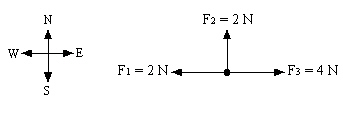 a. | The object will accelerate north. | b. | The object will be
motionless. | c. | The object will accelerate northeast. | d. | The object will travel with uniform
motion. | e. | The object will travel north with a constant
velocity. |
|
|
|
17.
|
Study the free-body diagram below and choose the statement that best describes
the dynamics of the situation. 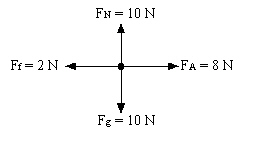 a. | There is no net horizontal force. | d. | The net force acting is 6
N. | b. | The net force acting is 30 N. | e. | The net force acting is 26
N. | c. | The net horizontal force is 10 N. |
|
|
|
18.
|
Study the free-body diagram below and determine what additional force(s) would
be required for the object to achieve uniform motion. 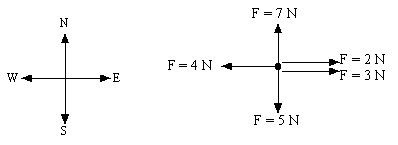 a. | 1 N [W] | d. | 2 N [S] and 1 N [E] | b. | 1 N
[E] | e. | 2 N
[S] and 1 N [W] | c. | 2 N [N] and 1 N
[W] |
|
|
|
19.
|
The free-body diagram shown below depicts the forces acting on an object. If the
object is to accelerate to the north, in what direction must an additional force be applied? 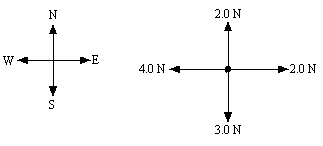 a. | north | d. | southeast | b. | northeast | e. | southwest | c. | northwest |
|
|
|
20.
|
The essence of Newton's first law was originally proposed by
a. | Aristotle | d. | Huygens | b. | Galileo | e. | Hooke | c. | Newton |
|
|
|
21.
|
Which of the following observations is explained by Newton's first
law?
a. | kicking your feet against something solid to remove snow from your
boots | b. | feeling as though you're being rocked from side-to-side on a roller
coaster | c. | an apple hanging motionless from the limb of a tree | d. | feeling as though
your head jerks backward when pulling away at green light | e. | all of the
above |
|
|
|
22.
|
Which of the following would Newton's first law alone NOT account
for?
a. | A rocket accelerates upward from a launch pad and the engines' thrust overcomes
gravity. | b. | A passenger leans forward in her seat when the car's brakes are
applied. | c. | Passengers on board an elevator undergoing uniform motion can't tell that the
elevator is really moving. | d. | No matter how hard you push against it, the
boulder would not move. | e. | During launch, astronauts feel that they are
being pushed back into their seats. |
|
|
|
23.
|
Two identical arrows, A and B, are fired with different bows. The bow that fires
arrow A exerts twice the average force as the bow that fires arrow B. Compare the accelerations of
the two arrows.
a. | Arrow B will have twice the acceleration of arrow A. | b. | Arrow A will have
twice the acceleration of arrow B. | c. | Arrow A and arrow B will have the same
acceleration. | d. | Arrow B will have four times the acceleration of arrow A. | e. | Arrow A will have
four times the acceleration of arrow B. |
|
|
|
24.
|
A heavy crate is pushed across a rough surface. The force that is ultimately
responsible for the crate's motion is the
a. | applied force | d. | net force | b. | frictional force | e. | normal force | c. | gravitational
force |
|
|
|
25.
|
A hockey puck of mass 150 g is sliding south along the ice and slows at a rate
of 1.2 m/s2. What is the net force acting on the puck?
a. | 1.8 ´ 102 N [N] | d. | 1.8 ´ 10-1 N [N] | b. | 1.8 ´ 102 N [S] | e. | 1.9 ´
10-1 N [S] | c. | 1.8 ´
101 N [N] |
|
|
|
26.
|
Newton's third law essentially states
a. | objects won't move unless pushed | b. | acceleration only occurs if there is net
force | c. | the acceleration of an object depends on its mass and the net force acting on
it | d. | objects which are moving tend to stay moving | e. | forces always occur
in pairs |
|
|
|
27.
|
The action and reaction forces of Newton's third law
a. | act on the same object | b. | act as a pair of forces that are
"balanced" | c. | make the net force zero because they are equal
in strength and opposite in direction | d. | act on two different
objects | e. | cancel each other out like Fg and
FN |
|
|
|
28.
|
A rocket accelerates upward and the thrust of the engines overcome the
frictional forces and the gravity acting against the rocket. Which of Newton's laws of motion
best explains this situation?
a. | Newton's first law | b. | Newton's second law | c. | Newton's third
law | d. | Newton's law of universal gravitation | e. | All the laws combine
to explain this situation. |
|
|
|
29.
|
Your "weight" is properly defined as
a. | the amount of material of which you are composed | b. | the gravitational
force which Earth exerts on you | c. | the gravitational force you exert on
Earth | d. | the force you exert on a set of bathroom scales | e. | none of the
above |
|
|
|
30.
|
The weight of an object in free fall just above Earth's surface is
a. | zero | d. | greater than normal | b. | less than normal | e. | almost zero | c. | normal |
|
|
|
31.
|
Your weight on board an orbiting space station would be
a. | normal | d. | slightly greater than normal | b. | only slightly less
than normal | e. | zero | c. | much less than
normal |
|
|
|
32.
|
If you weighed 112 N on the Moon where g = 1.6 N/kg, how much would you
weigh on Earth?
a. | 1.1 ´ 102 N | d. | 1.1 ´ 104 N | b. | 1.7 ´
104 N | e. | 6.9 ´ 103 N | c. | 6.9 ´
102 N |
|
|
|
33.
|
The value of "g" at the surface of Mars is 3.7 N/kg. How much
would a 60.0-kg person weigh at an altitude above the Martian surface equivalent to the planet's
radius?
a. | 2.2 ´ 102 N | d. | 56 N | b. | 1.6 ´ 102 N | e. | 28 N | c. | 1.1 ´ 102 N |
|
|
|
34.
|
Objects onboard an orbiting space station appear to be "floating"
because
a. | they're falling together | b. | they're weightless | c. | they're outside
Earth's gravitational pull | d. | they're in the vacuum of
space | e. | they're in the gravitational field of the Moon |
|
|
|
35.
|
According to Newton's law of universal gravitation, the gravitational force
of attraction between two objects would be
a. | half as strong if they're moved twice as far apart | b. | twice as strong if
they're moved half as far apart | c. | four times as strong if they're moved
twice as far apart | d. | four times as strong if they're moved half
as far apart | e. | twice as strong if they're moved twice as far
apart |
|
|
|
36.
|
If Earth was twice its present mass, but its size was not changed, you would
weigh
a. | half as much | d. | one-quarter as much | b. | twice as much | e. | the same amount | c. | four times as
much |
|
|
|
37.
|
If Earth's mass was four times what it is presently, what would its radius
have to be (comparably) so that the gravitational field strength at its surface would remain 9.8
N/kg?
a. | one-half as large | d. | four times larger | b. | one-quarter as large | e. | the same size | c. | twice as
large |
|
|
|
38.
|
Which of the following statements concerning gravitational fields is
true?
a. | Only very massive objects have gravitational fields. | b. | The gravitational
field strength of an object is one-quarter as great at twice the distance from the object's
centre. | c. | The strength of an object's gravitational field is inversely proportional to its
mass. | d. | The strength of an object's gravitational field is inversely proportional to the
square of its mass. | e. | The strength of an object's gravitational
field is inversely proportional to the distance from the object's
centre. |
|
|
|
39.
|
Which of the following statements concerning gravitational fields is
true?
a. | The strength of an object's gravitational field varies inversely as the square
of the distance to its centre. | b. | The strength of an object's gravitational
field varies directly as the square of its mass. | c. | The Moon's gravitational field is much
smaller than Earth's because the Moon's radius is so much smaller than
Earth's. | d. | An object's mass alone dictates the strength of the gravitational field at its
surface. | e. | An object's size alone dictates the strength of its gravitational
field. |
|
|
|
40.
|
The force of friction always acts in a direction exactly opposite to the
a. | applied force | d. | normal force | b. | net force | e. | motion | c. | gravitational
force |
|
|
|
41.
|
Study the force system diagram pictured below and select the factor which would
NOT influence the amount of kinetic friction. 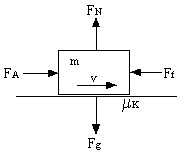 a. | object's mass, m | d. | applied force,
FA | b. | coefficient of kinetic friction, mK | e. | gravitational field strength, g | c. | normal force,
FN |
|
|
|
42.
|
Which of the following statements concerning friction is true?
a. | The frictional force always acts oppositely to the applied force. | b. | For two given
surfaces, the coefficient of static friction is generally greater than the coefficient of kinetic
friction. | c. | Friction is a force which is unavoidable and serves no practical
purpose. | d. | Two very highly-polished surfaces in contact with one another will have very little
friction between them. | e. | Friction always acts in the direction of
motion. |
|
|
|
43.
|
The coefficient of friction stems from the
a. | nature of the two surfaces in contact | d. | strength of the normal
force | b. | mass of the object | e. | strength of the gravitational force | c. | strength of the applied
force |
|
|
|
44.
|
If the strength of the frictional force is equal to the applied force and
oppositely directed, and assuming that all other forces may be ignored, the object
a. | must be at rest | b. | must be just about to move | c. | may be at rest or
moving at uniform velocity | d. | must be accelerating | e. | must be slowing
down |
|
|
|
45.
|
If all other forces can be ignored and the strength of the frictional force is
greater than the applied force and oppositely directed, the object
a. | could be speeding up or slowing down | b. | must be speeding up | c. | must be slowing
down | d. | could be moving with uniform motion | e. | could be
stopped |
|
Matching
|
|
|
Match each type of force with its description. a. | normal force | c. | frictional force | b. | gravitational force | d. | net force |
|
|
|
46.
|
This force is always perpendicular to the supporting surface.
|
|
|
47.
|
This force results from cohesive forces among particles in close
proximity.
|
|
|
48.
|
This force is ultimately responsible for the object's
acceleration.
|
|
|
49.
|
This force is exerted by all masses.
|
|
|
Match each of Newton's laws to the situation which they best
describe. a. | Newton's first law | c. | Newton's third
law | b. | Newton's second law | d. | Law of universal gravitation |
|
|
|
50.
|
The force that the Earth exerts on a group of astronauts gets progressively
weaker as their rocket rises vertically upward.
|
|
|
51.
|
At all times the astronauts exert as much force on the Earth as the Earth
exerts on them.
|
|
|
52.
|
The rocket accelerates upward and the engines' combined thrust overcomes
gravity.
|
|
|
53.
|
Astronauts feel as though they're being pushed back into their seats
during launch.
|